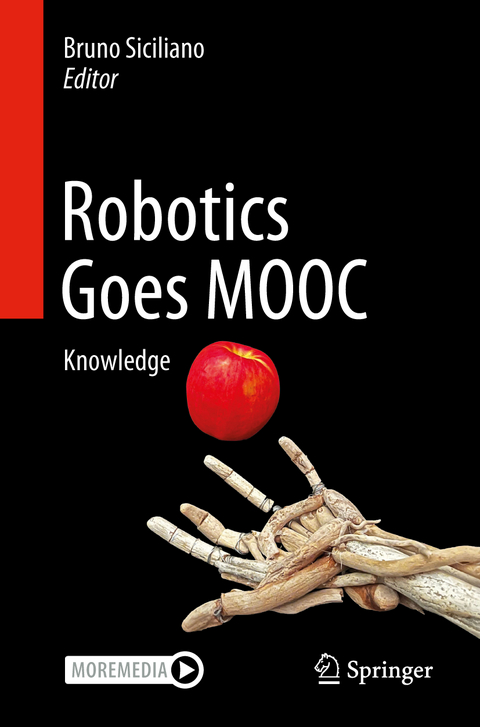
Robotics Goes MOOC
Springer International Publishing (Verlag)
978-3-319-74094-2 (ISBN)
- Noch nicht erschienen - erscheint am 17.03.2025
- Versandkostenfrei innerhalb Deutschlands
- Auch auf Rechnung
- Verfügbarkeit in der Filiale vor Ort prüfen
- Artikel merken
The robot "concept" was clearly established by those many creative historical realizations, such as those recalled above. Nonetheless, the emergence of the "physical" robot had to await the advent of its underlying technologies of mechanics, controls, computers, electronics and sensors in one word, mechatronics during the course of the twentieth century. As always, new designs motivate new research and discoveries which, in turn, lead to enhanced solutions and thus to novel concepts. This virtuous circle over time produced that knowledge and understanding which gave birth to the field of Robotics, properly referred to as the science and technology of robots.
To make robots and intelligent machines useful to humans it is necessary to have a broad and tight intersection between Robotics and AI. Sophisticated mathematical models are needed that enable the robot from a physical point of view, as well as intelligent algorithms capable of correlating all the information coming from the use of technologically advanced sensors with the data available from experience. It is expected that the synergy of model-based techniques with data-driven approaches will contribute to increasing the level of autonomy of robots and intelligent machines in the near future.
The first book of the Robotics Goes MOOC project starts with the journey of robotics in the introductory chapter by Khatib, who has pioneered our field of robotics and has ferried it to the third millennium. Sensing is crucial for the development of intelligent and autonomous robots, as covered in Chapter 2 by Nüchter et al. Model-based control is dealt with in Chapter 3 by Kröeger et al along with motion planning, as well as in Chapter 4 by Villani and Chapter 5 by Chaumette to handle force and visual feedback, respectively, when interacting with the environment. Resorting to AI techniques is the focus of the last part of the book, namely, Chapter 6 by Peters et al on Learning, Chapter 7 byBeetz et al on knowledge representation and reasoning, and Chapter 8 by Burgard et al on graph-based SLAM.Bruno Siciliano received his doctorate degree in Electronic Engineering from the University of Naples, Italy, in 1987. He is a professor of Control and Robotics at the University of Naples Federico II. His research focuses on methodologies and technologies in industrial and service robotics, including force and visual control, cooperative robots, human-robot interaction, and aerial manipulation. He has co-authored 6 books and over 300 journal papers, conference papers and book chapters. He has delivered more than 20 keynote presentations and over 100 colloquia and seminars at institutions around the world. He is a fellow of IEEE, ASME and IFAC, and co-editor of the Springer Tracts in Advanced Robotics (STAR) series and the Springer Handbook of Robotics, which received the PROSE Award for Excellence in Physical Sciences & Mathematics and was also the winner in the category Engineering & Technology. He has served on the editorial boards of prestigious journals, as well as chair or co-chair for numerous international conferences. Professor Siciliano is the past president of the IEEE Robotics and Automation Society (RAS). He has been the recipient of several awards, including the IEEE RAS George Saridis Leadership Award in Robotics and Automation and the IEEE RAS Distinguished Service Award.
1 Oussama Khatib, The Journey of Robotics.- 2 Dorit Borrmann and Andreas Nüchter, Sensing and Estimation.- 3 Lars Berscheid and Torsten Kröger, Control and Motion Planning.- 4 Luigi Villani, Force Control.- 5 Francois Chaumette, Visual Control.- 6 Joe Watson, Julen Urain, Joao Carvalho, Niklas Funk and Jan Peters, Learning.- 7 Michael Beetz and Daniel Nyga, Knowledge Representation and Reasoning- 8 Giorgio Grisetti, Rainer Kuemmerle, Cyrill Stachniss and Wolfram Burgard, Graph-Based SLAM.
| Erscheinungsdatum | 03.12.2023 |
|---|---|
| Zusatzinfo | Approx. 200 p. |
| Verlagsort | Cham |
| Sprache | englisch |
| Maße | 155 x 235 mm |
| Themenwelt | Technik ► Elektrotechnik / Energietechnik |
| Schlagworte | Design • Impact • interaction • Knowledge • Moocs • Robotics |
| ISBN-10 | 3-319-74094-6 / 3319740946 |
| ISBN-13 | 978-3-319-74094-2 / 9783319740942 |
| Zustand | Neuware |
| Haben Sie eine Frage zum Produkt? |
aus dem Bereich


